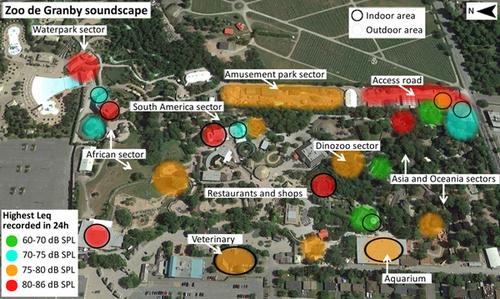Our official English website, www.x-mol.net, welcomes your
feedback! (Note: you will need to create a separate account there.)
Zoo soundscape: Daily variation of low‐to‐high‐frequency sounds
Zoo Biology ( IF 1.2 ) Pub Date : 2020-07-31 , DOI: 10.1002/zoo.21560 Catherine Pelletier 1 , Robert B Weladji 1 , Louis Lazure 1, 2 , Patrick Paré 2
Zoo Biology ( IF 1.2 ) Pub Date : 2020-07-31 , DOI: 10.1002/zoo.21560 Catherine Pelletier 1 , Robert B Weladji 1 , Louis Lazure 1, 2 , Patrick Paré 2
Affiliation

|
Most studies assessing the impact of noises on zoo animal welfare did not measure sound frequencies outside of the human-hearing range (infrasounds and ultrasounds). Many nonhuman mammals can hear these frequencies, and because loud and variable soundscapes are potentially detrimental for animal welfare, this overlooked aspect of their acoustic environment could have important consequences. This study evaluated the soundscape of an urban zoo in a large frequency range (17.5-90,510 Hz) by measuring its average sound levels (Leq ) and variability (the difference between highest and lowest peaks). Sound data were collected for 24 hr in 25 locations (e.g., indoor, outdoor, near the amusement park). The soundscape was not considered problematic for animal welfare when looking at the average sound levels in most locations (<77-dB sound pressure level [SPL]), except for a few indoor areas and near the water park. Ultrasounds were rare, had low average sound levels, and were less variable in time. Infrasounds were always present and were the loudest and most variable sound frequencies. The soundscape was louder and more variable during the day and when visitors were present, suggesting that human-related activities were the sources of these augmentations. Indoor environments were generally louder than outdoor environments and touristic features; however, the water park was near 85-dB SPL during the day. On the basis of results, we suggest a series of mitigation actions to minimize noise-related stress in captive animals.
中文翻译:

动物园音景:低频到高频声音的日常变化
大多数评估噪音对动物园动物福利影响的研究并没有测量人类听觉范围之外的声音频率(次声和超声波)。许多非人类哺乳动物可以听到这些频率,而且由于嘈杂和多变的声景可能对动物福利有害,因此它们声环境中这一被忽视的方面可能会产生重要后果。本研究通过测量城市动物园的平均声级 (Leq) 和可变性(最高和最低峰值之间的差异)来评估大频率范围 (17.5-90,510 Hz) 的声景。在 25 个地点(例如,室内、室外、游乐园附近)收集了 24 小时的声音数据。在查看大多数位置的平均声级时,音景不被认为对动物福利有问题(< 77-dB 声压级 [SPL]),除了一些室内区域和水上乐园附近。超声波很少见,平均声级低,时间变化较小。次声总是存在并且是最响亮和最可变的声音频率。白天和游客在场时,声景更响亮且变化更大,这表明与人类相关的活动是这些增强的来源。室内环境通常比室外环境和旅游特色响亮;然而,水上乐园白天的声压级接近 85 分贝。根据结果,我们建议采取一系列缓解措施,以尽量减少圈养动物与噪音相关的压力。次声总是存在并且是最响亮和最可变的声音频率。白天和游客在场时,声景更响亮且变化更大,这表明与人类相关的活动是这些增强的来源。室内环境通常比室外环境和旅游特色响亮;然而,水上乐园白天的声压级接近 85 分贝。根据结果,我们建议采取一系列缓解措施,以尽量减少圈养动物与噪音相关的压力。次声总是存在并且是最响亮和最可变的声音频率。白天和游客在场时,声景更响亮且变化更大,这表明与人类相关的活动是这些增强的来源。室内环境通常比室外环境和旅游特色响亮;然而,水上乐园白天的声压级接近 85 分贝。根据结果,我们建议采取一系列缓解措施,以尽量减少圈养动物与噪音相关的压力。室内环境通常比室外环境和旅游特色响亮;然而,水上乐园白天的声压级接近 85 分贝。根据结果,我们建议采取一系列缓解措施,以尽量减少圈养动物与噪音相关的压力。室内环境通常比室外环境和旅游特色响亮;然而,水上乐园白天的声压级接近 85 分贝。根据结果,我们建议采取一系列缓解措施,以尽量减少圈养动物与噪音相关的压力。
更新日期:2020-07-31
中文翻译:

动物园音景:低频到高频声音的日常变化
大多数评估噪音对动物园动物福利影响的研究并没有测量人类听觉范围之外的声音频率(次声和超声波)。许多非人类哺乳动物可以听到这些频率,而且由于嘈杂和多变的声景可能对动物福利有害,因此它们声环境中这一被忽视的方面可能会产生重要后果。本研究通过测量城市动物园的平均声级 (Leq) 和可变性(最高和最低峰值之间的差异)来评估大频率范围 (17.5-90,510 Hz) 的声景。在 25 个地点(例如,室内、室外、游乐园附近)收集了 24 小时的声音数据。在查看大多数位置的平均声级时,音景不被认为对动物福利有问题(< 77-dB 声压级 [SPL]),除了一些室内区域和水上乐园附近。超声波很少见,平均声级低,时间变化较小。次声总是存在并且是最响亮和最可变的声音频率。白天和游客在场时,声景更响亮且变化更大,这表明与人类相关的活动是这些增强的来源。室内环境通常比室外环境和旅游特色响亮;然而,水上乐园白天的声压级接近 85 分贝。根据结果,我们建议采取一系列缓解措施,以尽量减少圈养动物与噪音相关的压力。次声总是存在并且是最响亮和最可变的声音频率。白天和游客在场时,声景更响亮且变化更大,这表明与人类相关的活动是这些增强的来源。室内环境通常比室外环境和旅游特色响亮;然而,水上乐园白天的声压级接近 85 分贝。根据结果,我们建议采取一系列缓解措施,以尽量减少圈养动物与噪音相关的压力。次声总是存在并且是最响亮和最可变的声音频率。白天和游客在场时,声景更响亮且变化更大,这表明与人类相关的活动是这些增强的来源。室内环境通常比室外环境和旅游特色响亮;然而,水上乐园白天的声压级接近 85 分贝。根据结果,我们建议采取一系列缓解措施,以尽量减少圈养动物与噪音相关的压力。室内环境通常比室外环境和旅游特色响亮;然而,水上乐园白天的声压级接近 85 分贝。根据结果,我们建议采取一系列缓解措施,以尽量减少圈养动物与噪音相关的压力。室内环境通常比室外环境和旅游特色响亮;然而,水上乐园白天的声压级接近 85 分贝。根据结果,我们建议采取一系列缓解措施,以尽量减少圈养动物与噪音相关的压力。











































 京公网安备 11010802027423号
京公网安备 11010802027423号